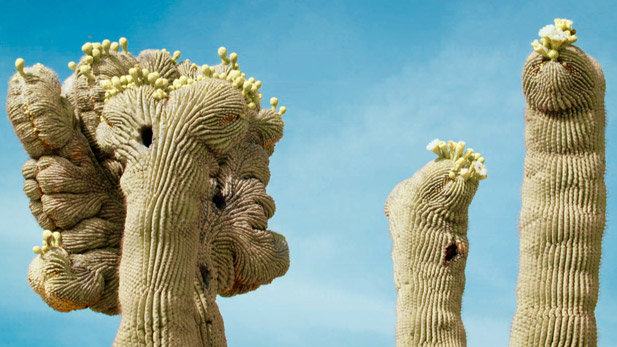 A saguaro cactus flower blossom.
A saguaro cactus flower blossom.
Researchers have found a genetic pattern in the saguaro and its cousins that could explain why many cactus species resist simple classification.
The findings represent four years of effort by scientists from University of Arizona; Arizona State University; Universidad Nacional Autónoma de México, in Mexico City and Hermosillo; University of California, Berkeley; Michigan State University; and International Rice Research Institute, Los Baños, Laguna, Philippines.
The paper appeared in the Oct. 23 online edition of PNAS.
Classification seems fairly easy: Compare things, see what resembles what and arrange a family tree accordingly.
But plants like the cactus are tricky. Distant relatives can look like twins or evolve similar traits, thanks to phenomena like parallel and convergent evolution, both of which entail species evolving the same traits independently of one another.
“So many species of cacti are so similar to one another and difficult to tell apart that there remain a very large number of mysteries in the diversity of cacti,” said Mike Sanderson, UA evolutionary biologist and senior author on the paper.
“What is the closest relative to the saguaro cactus? That has not been clear,” Sanderson said.
To test the hypothesis that rampant convergent and parallel evolution might partially explain why some cacti are so difficult to classify, Sanderson and his colleagues sequenced the genomes of four large columnar cacti found in Mexico and nearby areas.
Taken from the genera Pachycereus, Lophocereus and Stenocereus, these included the Sonoran Desert saguaro (Carnegiea gigantea).
To provide a baseline for comparison, the team also sequenced a more distant saguaro relative: a leafy, shrub-like tropical cactus from the genus Pereskia.
Their findings revealed another cause for the cactus confusion: a mismatch between species history, the evolutionary family tree and genetic history, the fate of each gene variant as it was passed on, or lost, in each branch.
This mismatch, or hemiplasy, is a relatively new concept, one that arose over the past decade thanks to data made available by the genomic revolution.
"This seems to be exceptionally bad in these long-lived cacti, and may in part explain why these puzzles have lingered — and why it's been hard to understand the closest relatives of various groups of these cacti," Sanderson said.
 A crested saguaro.
A crested saguaro.It's logical to imagine that genetic history would march in lockstep with evolutionary branching. It makes sense that humans, for example, would mainly share gene variants, or alleles, with their recent common ancestors like chimps or bonobos.
But that need not always be the case. With hemiplasy, we could end up sharing an allele or two with a cousin whose branch diverged further back in time, such as the gorilla, even if chimps and bonobos lack that variant.
Sanderson and his colleagues realized that this genomic mosaic might help explain the often confusing array of traits found among cactuses.
“Since those genes affect those traits, the fact that they have histories that don't match the history of the species means that the traits that you're looking at can actually be sort of scrambled with respect to what you might expect,” said Sanderson.
The researchers believe that cactuses' long lives and long generation times might help to explain their high rate of hemiplasy: The longer an organism lives, and the longer it takes to spawn a new generation, the fewer generations occur within a given period. That leaves fewer opportunities for nature to sort things out.
Meanwhile, Sanderson said the new trove of data offers new avenues of research, possibly including additional cactus sequencing or a comparative study of northern and southern saguaros.
"I see this work as a step in the direction of understanding how plants have evolved to cope with absolutely extreme environments," Sanderson said.


By submitting your comments, you hereby give AZPM the right to post your comments and potentially use them in any other form of media operated by this institution.